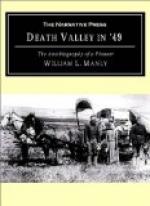We passed on from Soledad and shortly rose into the table land we had seen for some time before us. From here we could look north for a long way with no hill or mountain in sight; but our road led along on the east side of this treeless plain, so thickly covered with grass that we recalled some of the old tales of the grassy plains. We passed a landholder’s house on the road, then crossed a range of low mountains and came to the Mission of San Juan (St. John) situated near the foot-hills, overlooking a level, rich appearing extent of valley land with a big vegetable growth all over it; in some places wild mustard which stood thickly and was from four to ten feet high. I thought what a splendid place it would be for the Yankees who are fond of greens.
This was the first place since we left Los Angeles where we could buy any kind of breadstuff, and we were here enabled to get a change of diet, including greens. This seemed to be one end or side of another valley, and as we went along it seemed to widen away to the east; but our course was to the north, and we followed the road. The architecture of all the buildings except the churches was all the same, being built of the sun dried adobes or bricks made by mixing up a clay mud with tough grass and letting it get dry and hard. We saw the same kind of roof material as before, a sort of mineral tar which I supposed they must find somewhere about.
I could imagine why the houses were built in this way, for when the Jesuit missionaries first came in they found the country occupied by Indians who used their arrows to good effect, as they were jealous of all outside occupation. The early settlers evidently made the walls of their dwellings thick and strong enough to resist all kinds of weapons used by Indians. They could not set fire to them for they were fire proof and arrow proof, and the hostile Indian could dance on the roof without being able to get in or do any injury. Thus the poor Indian was fairly beat and eventually became a better Indian.




